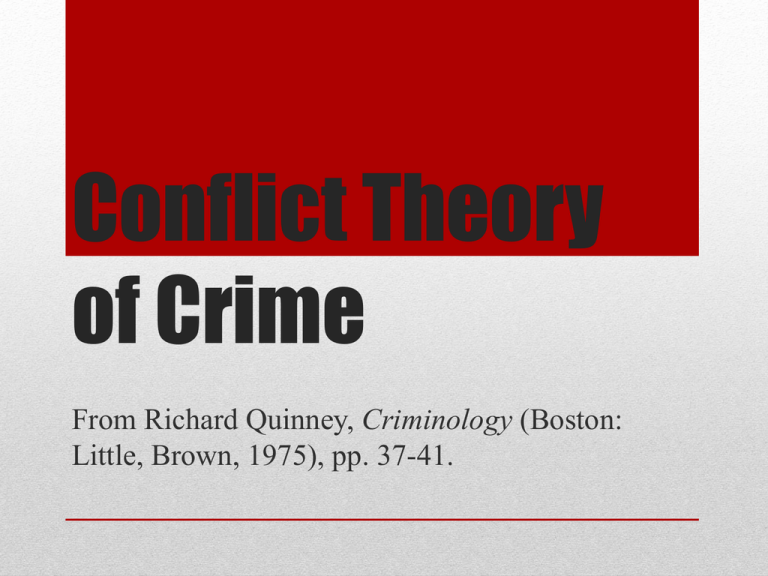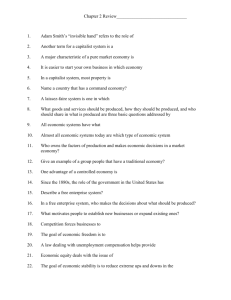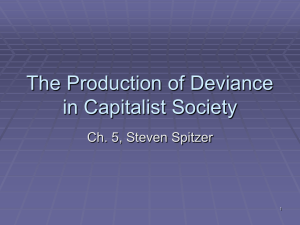6/5 – Conflict Theory - Deviance & Social Pathology
advertisement

Conflict Theory of Crime From Richard Quinney, Criminology (Boston: Little, Brown, 1975), pp. 37-41. Formulation of definitions of crime Application of definitions of crime Class Struggle & Class Conflict Construction of the ideology of crime Development of behavior patterns in relation to definitions of crime The social reality of crime • Crime as a legal definition of human conduct is created by agents of the dominant class in a politically organized society I. The Official Definition of Crime • Definitions of crime are composed of behaviors that conflict with the interests of the dominant class II. Formulating Definitions of Crime • Definitions of crime are applied by the class that has the power to shape the enforcement and administration of the law III. Applying Definitions of Crime • Behavior patterns are structured in relation to definitions of crime, and within this context people engage in actions that have relative probabilities of being defined as criminal. IV. How Behavior Patterns Develop in Relation to Definitions of Crime • An ideology of crime is constructed and diffused by the dominant class to secure its hegemony (or ideological domination) V. Constructing an Ideology of Crime “Social Junk” vs “Social Dynamite” From Steven Spitzer, The Production of Deviance in Capitalist Society (1975) 8 Deviance within capitalist society • the capitalist mode of production has two key features: • it forms the foundation or infrastructure of society • it contains internal contradictions • Marxist theory illustrates the relationship between specific contradictions, the problems of capitalist development, and the production of a “deviant class” 9 Infrastructure & Superstructure • superstructure: the ideologies that dominate a particular era, all that "men say, imagine, conceive," including such things as "politics, laws, morality, religion, metaphysics, etc." • emerges from and reflects the ongoing development of economic forces (infrastructure) • in class societies, the superstructure preserves the hegemony of the ruling class through a system of class controls, which are institutionalized in: • family, church, private associations, media, schools & the state • key function of the superstructure is the regulation and management of “problem populations” 10 Problem populations become eligible for management as deviant when they disturb, hinder, or call into question: • • • • • capitalist modes of appropriation social conditions of production patterns of distribution & consumption capitalist socialization processes the ideology which supports capitalism 11 problem populations • tend to share social characteristics • most important is the fact that their behavior, personal qualities, and/or position threaten the social relations of production in capitalist societies • are not synonymous w/deviant populations • some members of problem populations are successfully transformed into supporters of the capitalist order; the rest are “candidates for deviance processing” (68) 12 Problem populations are created in 2 ways • directly: as a product of the contradictions of capitalism • by creating a “relative surplus population,” i.e., people who are unemployed and disposable, whose labor is not required for the system • indirectly: through disturbances in the system of class rule • when institutions, e.g., mass education, fails to promote the values of bourgeois/capitalist society 13 Official social control creates two kinds of problem populations • social junk • social dynamite 14 social junk • a group that fails to participate in the roles supportive of capitalist society • they are viewed as costly yet relatively harmless by the dominant class • e.g., the officially administered aged, the handicapped, the mentally ill and mentally disabled • social control is managed by the therapeutic & welfare state, i.e., programs like Social Security, Medicare, and Medicaid 15 social dynamite • a group with the potential to call into question established relationships, esp. relations of production and domination • poses a more acute problem that requires rapid and focused expenditures • tends to be more youthful, alienated, and politically more volatile than social junk • social control is handled by the legal/criminal justice system 16






